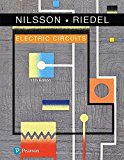
Concept explainers
a.
Calculate the fundamental frequency
a.
Answer to Problem 1P
The fundamental frequency
Explanation of Solution
Calculation:
Consider that the expression for the fundamental frequency
Substitute
Substitute
Conclusion:
Thus, the fundamental frequency
b.
Calculate the frequency
b.
Answer to Problem 1P
The fundamental frequency
Explanation of Solution
Calculation:
Consider that the expression for the frequency
Substitute
Substitute
Conclusion:
Thus, the fundamental frequency
c.
Calculate the Fourier co-efficient
c.
Answer to Problem 1P
The Fourier co-efficient
Explanation of Solution
Calculation:
For the periodic voltage in part (a), the Fourier co-efficient
Calculate the Fourier co-efficient
Conclusion:
Thus, the Fourier co-efficient
d.
Calculate the Fourier co-efficients
d.
Answer to Problem 1P
The Fourier co-efficients
Explanation of Solution
Calculation:
For the periodic voltage in part (a), the Fourier co-efficient
Calculate the Fourier co-efficient
And
Calculate the Fourier co-efficient
And
The Fourier co-efficient
Calculate the Fourier co-efficient
Calculate the Fourier co-efficient
Conclusion:
Thus, the Fourier co-efficients
e.
Derive the Fourier series expression for the voltage
e.
Answer to Problem 1P
The Fourier series expression of voltage
Explanation of Solution
Calculation:
Write the Fourier series expression of voltage
Write the Fourier series expression of voltage
Conclusion:
Thus, the Fourier series expression of voltage
Want to see more full solutions like this?
Chapter 16 Solutions
Electric Circuits Plus Mastering Engineering with Pearson eText 2.0 - Access Card Package (11th Edition) (What's New in Engineering)
- In the control system shown in Figure Q4(a), G₁(s) = and G₂(s) == If the system has the specifications for the natural frequency and dampingratio of -5 rad/sec and {=0.7, respectively, determine K and H,(s) when H₂(s) = 1.arrow_forwardCan the expert help me draw a curve on my graph paper? TERMINAL VOLTS 9000 8000 7000 6000 5000 4100 4000 14 18 22 26 30 34 38 FIELD AMPERES, If OPEN CIRCUIT CHARACTERSTICS Fig 3 42 42 46 50 54arrow_forwardSolve this problem and show all of the workarrow_forward
- 4. A 120/240 volt 10kVA two-winding transformer is to be reconnected as a step-up 120/360 volt auto-transformer. What is the kVA rating of the new auto- transformer connection? (10 pts)arrow_forwardSolve this problem and show all of the workarrow_forward3. The total power consumed by a balanced three-phase 480 volts rms line-to-line system is 13.3 kW and 9.97 kVARS. Determine the current (both magnitude and phase) supplied to the load. (10 pts)arrow_forward
- 2. Determine the rms current (magnitude and phase) supplied by the 120 volt rms source in the circuit shown below. Assume the transformer is ideal. (20 pts) 120 Loo Volts rms. j452 1:3 272arrow_forward6. Find the transfer function H(jw) = Vo(jw)/Vs(jw). Determine the type of filter (i.e. lowpass, highpass) (20 pts) Vs Rz R₁ L +1 Noarrow_forward1. A balanced three-phase voltage source with a line-to-line magnitude of 208 volts rms supplies a balanced delta-connected load of 12 + j9 ohms per-phase. Determine the rms magnitude of the current that will flow in the lines connecting the voltage source to the load. (20 pts)arrow_forward
- 5. For the circuit shown below determine the following quantities: a. An expression for the transfer relationship H(jw) = Vo(jw) / Vs(jw). b. The maximum value of the transfer relationship. c. Identify the type of filter (i.e. low pass, high pass) d. Determine the cutoff frequency if R₁ = 10k ohms, R2 = 12k ohms and L= 10H. (20 pts) + Vs ① R₁ + L Vo R2arrow_forwardpower systemsarrow_forwardpower systemsarrow_forward
 Introductory Circuit Analysis (13th Edition)Electrical EngineeringISBN:9780133923605Author:Robert L. BoylestadPublisher:PEARSON
Introductory Circuit Analysis (13th Edition)Electrical EngineeringISBN:9780133923605Author:Robert L. BoylestadPublisher:PEARSON Delmar's Standard Textbook Of ElectricityElectrical EngineeringISBN:9781337900348Author:Stephen L. HermanPublisher:Cengage Learning
Delmar's Standard Textbook Of ElectricityElectrical EngineeringISBN:9781337900348Author:Stephen L. HermanPublisher:Cengage Learning Programmable Logic ControllersElectrical EngineeringISBN:9780073373843Author:Frank D. PetruzellaPublisher:McGraw-Hill Education
Programmable Logic ControllersElectrical EngineeringISBN:9780073373843Author:Frank D. PetruzellaPublisher:McGraw-Hill Education Fundamentals of Electric CircuitsElectrical EngineeringISBN:9780078028229Author:Charles K Alexander, Matthew SadikuPublisher:McGraw-Hill Education
Fundamentals of Electric CircuitsElectrical EngineeringISBN:9780078028229Author:Charles K Alexander, Matthew SadikuPublisher:McGraw-Hill Education Electric Circuits. (11th Edition)Electrical EngineeringISBN:9780134746968Author:James W. Nilsson, Susan RiedelPublisher:PEARSON
Electric Circuits. (11th Edition)Electrical EngineeringISBN:9780134746968Author:James W. Nilsson, Susan RiedelPublisher:PEARSON Engineering ElectromagneticsElectrical EngineeringISBN:9780078028151Author:Hayt, William H. (william Hart), Jr, BUCK, John A.Publisher:Mcgraw-hill Education,
Engineering ElectromagneticsElectrical EngineeringISBN:9780078028151Author:Hayt, William H. (william Hart), Jr, BUCK, John A.Publisher:Mcgraw-hill Education,





